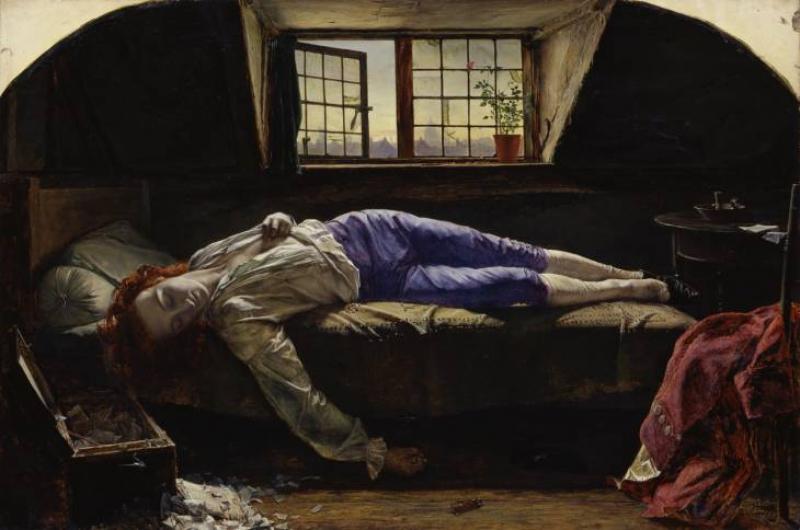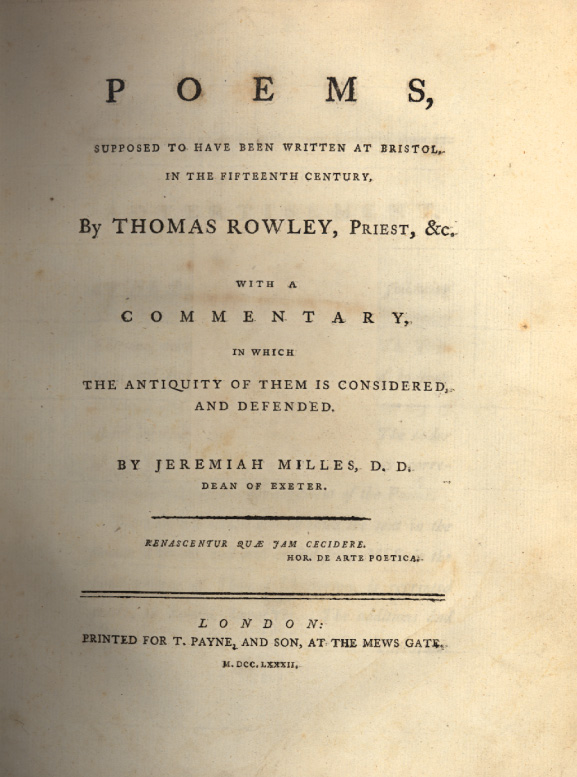Thomas Chatterton: The Myth of the Doomed Poet, BBC Four | reviews, news & interviews
Thomas Chatterton: The Myth of the Doomed Poet, BBC Four
Thomas Chatterton: The Myth of the Doomed Poet, BBC Four
The original druggy young genius is brought back to life

The young casualty of genius fires imaginations and fills coffers. Last year Dylan Thomas’s centenary was vastly celebrated. The Amy Winehouse industry is still shifting units. The spell cast by Sylvia Plath seems not to diminish. A Janis Joplin biopic project is staggering through the law courts. And then there are Jim Morrison, Kurt Cobain, Jimi Hendrix, old Uncle Tom Cobbleigh and all the sundry other singers and poets who, by accident or design, cut themselves down in their prime.
Chatterton’s was a career consisting mainly of slumps. As a young Bristolian, he was taken up by Horace Walpole, the antiquity-fancier and author of the proto-Gothic novel The Castle of Otranto, then dropped like a stone. The vast medieval poem by one "Thomas Rowley, priest" (pictured below), inscribed on ancient parchment Chatterton claimed to have unearthed in a chest in his local church in Bristol, was deemed by Thomas Grey to be a fake. His creative career was over before it started. He then made his way up to London and became a political journalist writing anti-establishment rants under such provocative pseudonyms as Vamp and Harry Wildfire. But that too suffered a blow when a powerful patron, Mayor of London William Beckford (father of the author of Vathek), died of a fever. Chatterton soon followed him to the grave.
The impression left behind was of a genius who could serve his artistic purpose only by dying young
And it was then, contended poet Michael Symmons Roberts in this thoughtful documentary, that Chatterton’s career really started. Keats and Shelley doffed their caps. Wordsworth dubbed him “the marvellous boy”. When the Victorians, and specifically the Pre-Raphaelites, started to take a morbid interest in death, a romantic portrait of Chatterton on his deathbed by Henry Wallis toured the nation. With searing blue breeches, a bright white chemise and a shock of flaming red hair, his corpse looked like a French tricolour. The colours came up a treat when James Robinson, a dental surgeon turned photographer, recreated the touching scene for the new-fangled art of stereoscopy, in which depth of focus was added to postcards when seen through a special viewfinder. “Give me a Chatterton attic,” wrote Dylan Thomas.
 Symmons Roberts set out to interrogate the myth of the poet as doomed risk-taker. His most startling revelation came in Bristol library, where Chatterton’s pocket book from the year before he died was shot through with brown stains containing opium. The conclusion is that, rather than take his own life in an act of creative despair, it’s more likely that he overdosed on laudanum he was taking to dull the pain of his anti-venereal medication. Chatterton had the clap.
Symmons Roberts set out to interrogate the myth of the poet as doomed risk-taker. His most startling revelation came in Bristol library, where Chatterton’s pocket book from the year before he died was shot through with brown stains containing opium. The conclusion is that, rather than take his own life in an act of creative despair, it’s more likely that he overdosed on laudanum he was taking to dull the pain of his anti-venereal medication. Chatterton had the clap.
Oh for more such half-hour documentaries. Chatterton’s brief life was covered in a brief essay in which Symmons Roberts said what was needed (he was given much longer to explore the convolutions of William Carlos Williams in his excellent meta-drama recently on Radio 3). There were interviews with a curator at Tate Britain and with Brian May, who in another life is a leading stereoscopy collector. A little bit more on the quality or otherwise of Chatterton’s poetry might have been welcome.
The impression left behind was of a great pretender who could serve his artistic purpose only by dying young. A genius at literary mimicry, he should have been alive today, when a postmodern career peddling fakery would have sat more comfortably among the halls and mirrors of contemporary art.
rating
Explore topics
Share this article
Add comment
The future of Arts Journalism
You can stop theartsdesk.com closing!
We urgently need financing to survive. Our fundraising drive has thus far raised £49,000 but we need to reach £100,000 or we will be forced to close. Please contribute here: https://gofund.me/c3f6033d
And if you can forward this information to anyone who might assist, we’d be grateful.

Subscribe to theartsdesk.com
Thank you for continuing to read our work on theartsdesk.com. For unlimited access to every article in its entirety, including our archive of more than 15,000 pieces, we're asking for £5 per month or £40 per year. We feel it's a very good deal, and hope you do too.
To take a subscription now simply click here.
And if you're looking for that extra gift for a friend or family member, why not treat them to a theartsdesk.com gift subscription?
more TV
 Murder Before Evensong, Acorn TV review - death comes to the picturesque village of Champton
The Rev Richard Coles's sleuthing cleric hits the screen
Murder Before Evensong, Acorn TV review - death comes to the picturesque village of Champton
The Rev Richard Coles's sleuthing cleric hits the screen
 Black Rabbit, Netflix review - grime and punishment in New York City
Jude Law and Jason Bateman tread the thin line between love and hate
Black Rabbit, Netflix review - grime and punishment in New York City
Jude Law and Jason Bateman tread the thin line between love and hate
 The Hack, ITV review - plodding anatomy of twin UK scandals
Jack Thorne's skill can't disguise the bagginess of his double-headed material
The Hack, ITV review - plodding anatomy of twin UK scandals
Jack Thorne's skill can't disguise the bagginess of his double-headed material
 Slow Horses, Series 5, Apple TV+ review - terror, trauma and impeccable comic timing
Jackson Lamb's band of MI5 misfits continues to fascinate and amuse
Slow Horses, Series 5, Apple TV+ review - terror, trauma and impeccable comic timing
Jackson Lamb's band of MI5 misfits continues to fascinate and amuse
 Coldwater, ITV1 review - horror and black comedy in the Highlands
Superb cast lights up David Ireland's cunning thriller
Coldwater, ITV1 review - horror and black comedy in the Highlands
Superb cast lights up David Ireland's cunning thriller
 Blu-ray: The Sweeney - Series One
Influential and entertaining 1970s police drama, handsomely restored
Blu-ray: The Sweeney - Series One
Influential and entertaining 1970s police drama, handsomely restored
 I Fought the Law, ITVX review - how an 800-year-old law was challenged and changed
Sheridan Smith's raw performance dominates ITV's new docudrama about injustice
I Fought the Law, ITVX review - how an 800-year-old law was challenged and changed
Sheridan Smith's raw performance dominates ITV's new docudrama about injustice
 The Paper, Sky Max review - a spinoff of the US Office worth waiting 20 years for
Perfectly judged recycling of the original's key elements, with a star turn at its heart
The Paper, Sky Max review - a spinoff of the US Office worth waiting 20 years for
Perfectly judged recycling of the original's key elements, with a star turn at its heart
 The Guest, BBC One review - be careful what you wish for
A terrific Eve Myles stars in addictive Welsh mystery
The Guest, BBC One review - be careful what you wish for
A terrific Eve Myles stars in addictive Welsh mystery
 theartsdesk Q&A: Suranne Jones on 'Hostage', power pants and politics
The star and producer talks about taking on the role of Prime Minister, wearing high heels and living in the public eye
theartsdesk Q&A: Suranne Jones on 'Hostage', power pants and politics
The star and producer talks about taking on the role of Prime Minister, wearing high heels and living in the public eye
 King & Conqueror, BBC One review - not many kicks in 1066
Turgid medieval drama leaves viewers in the dark
King & Conqueror, BBC One review - not many kicks in 1066
Turgid medieval drama leaves viewers in the dark
 Hostage, Netflix review - entente not-too-cordiale
Suranne Jones and Julie Delpy cross swords in confused political drama
Hostage, Netflix review - entente not-too-cordiale
Suranne Jones and Julie Delpy cross swords in confused political drama

Comments
Another nugget of gold on